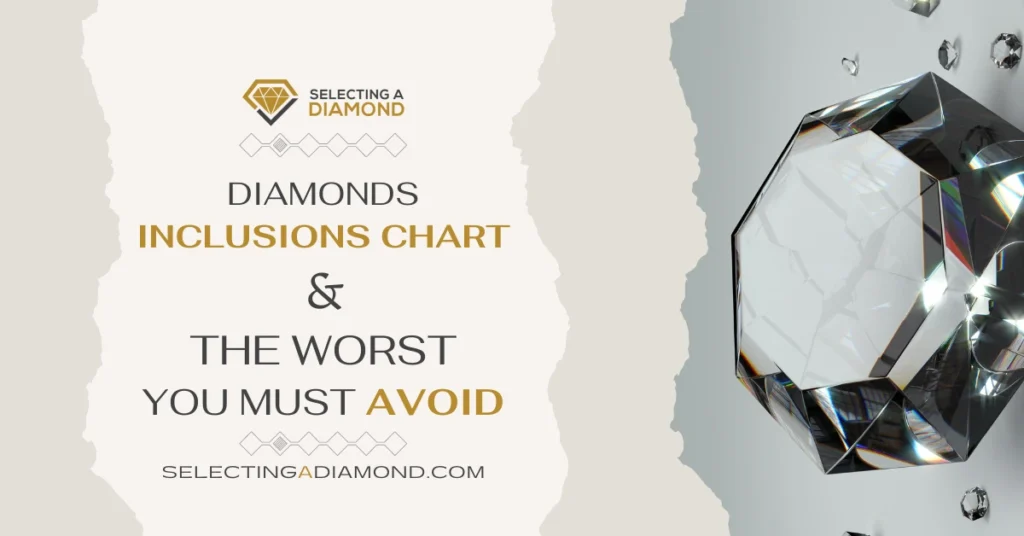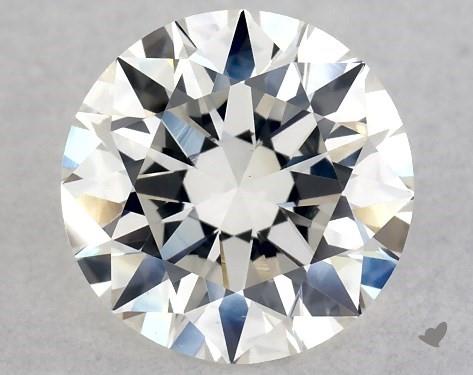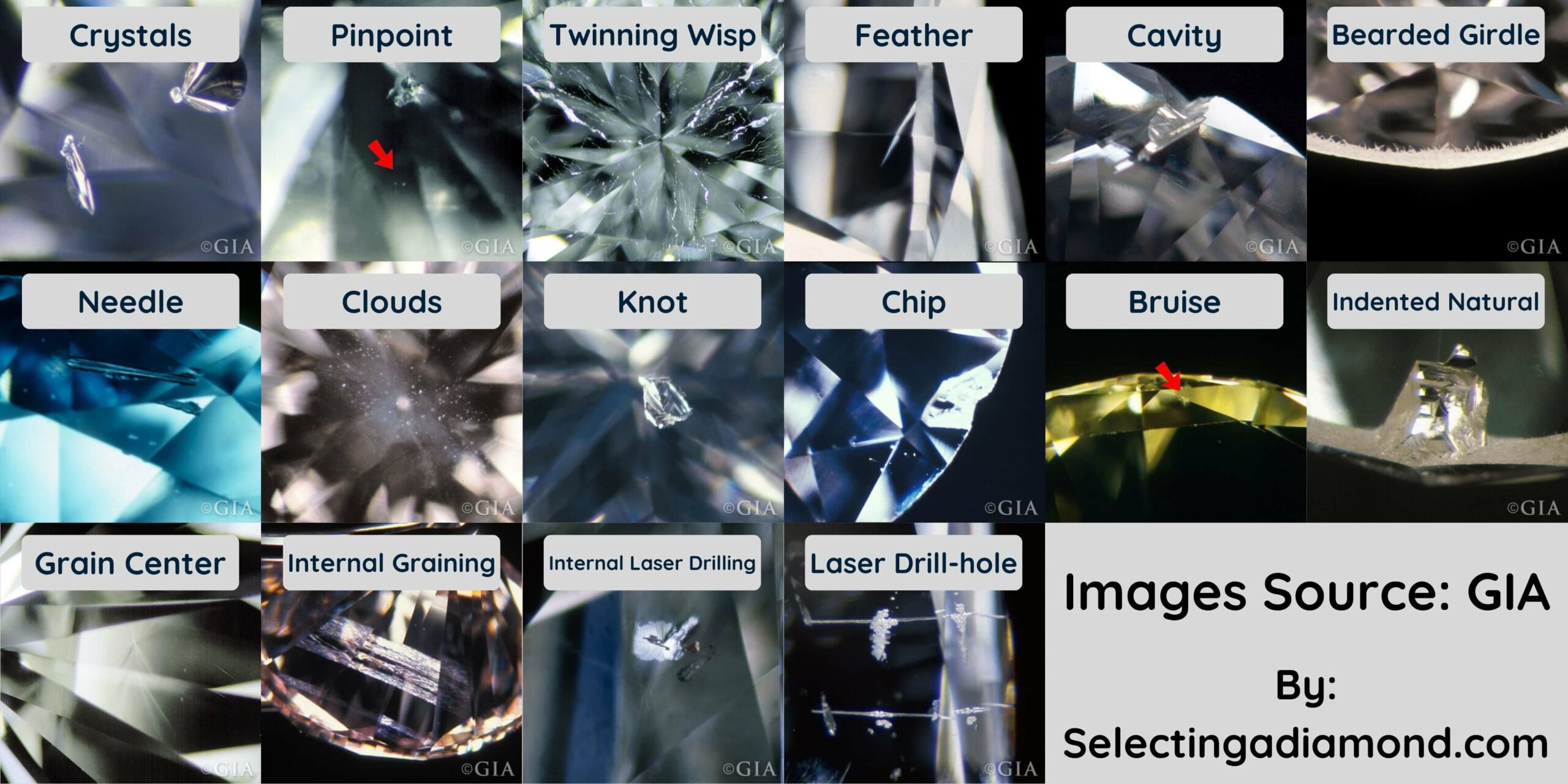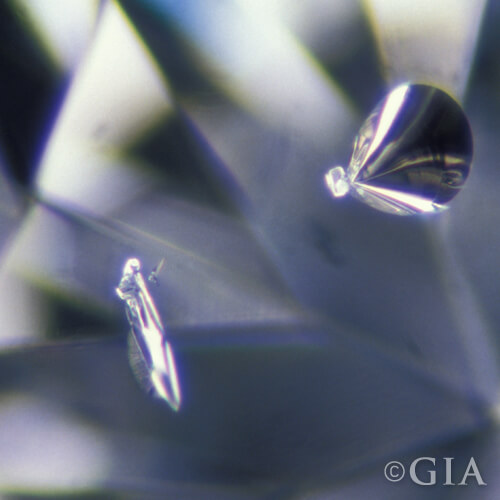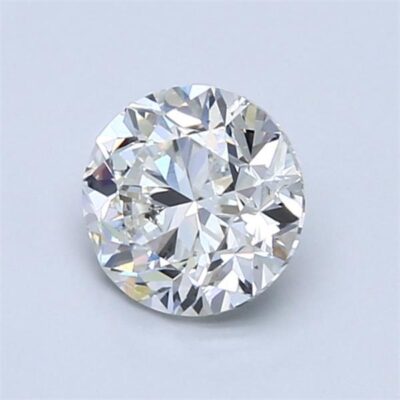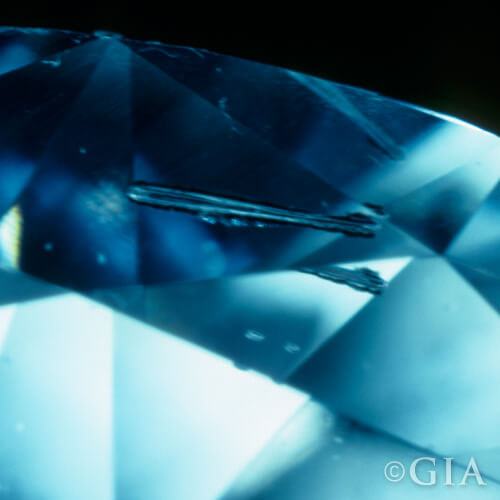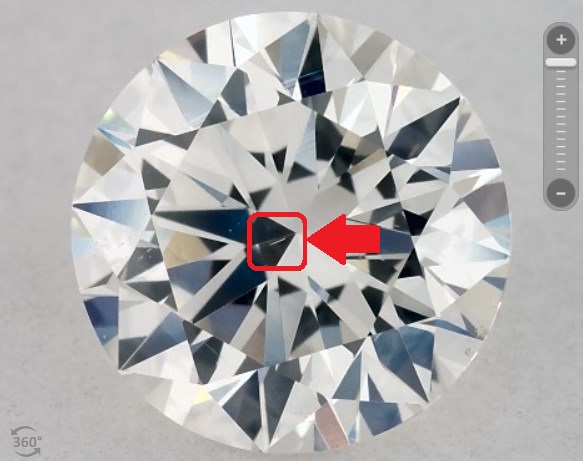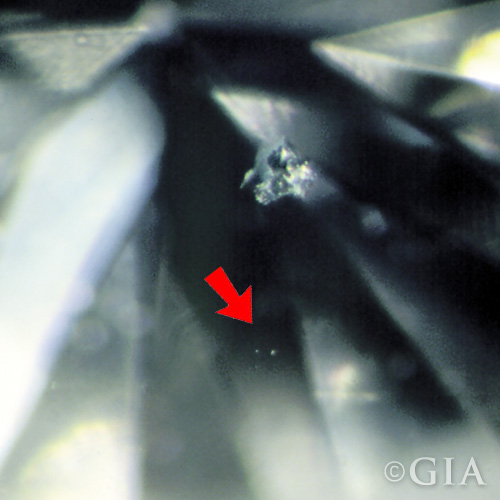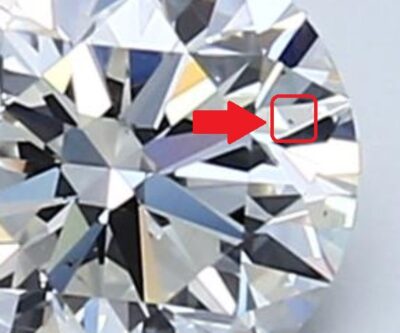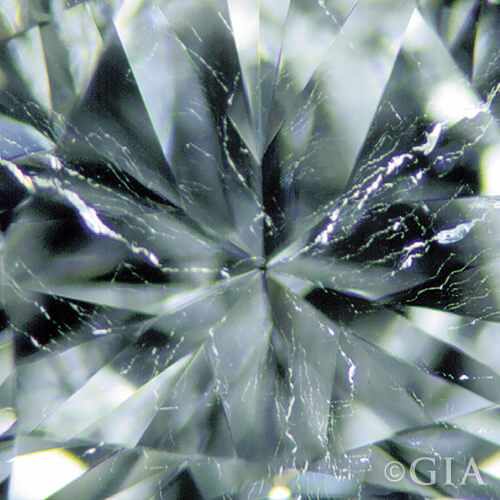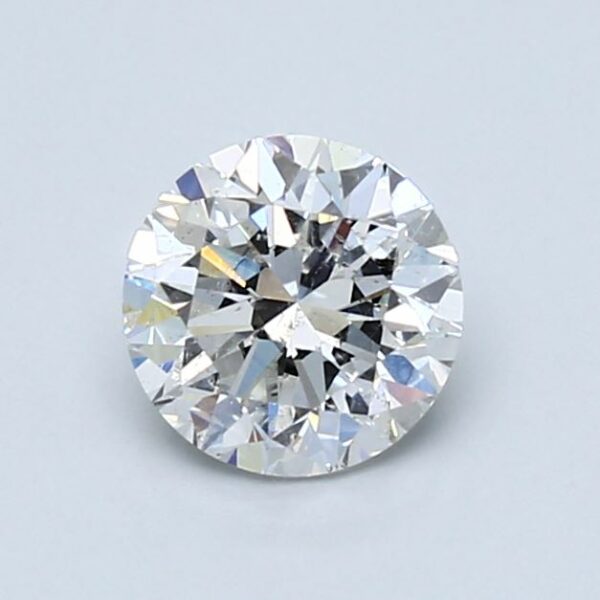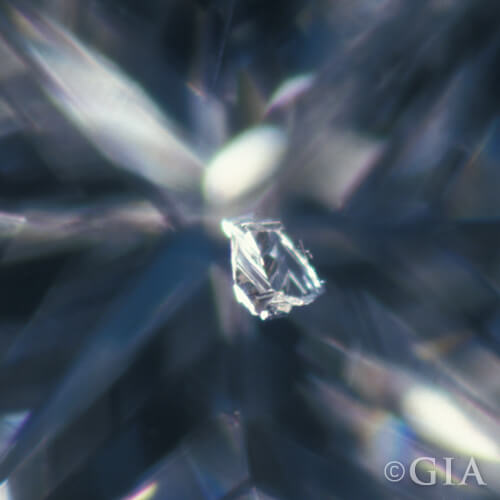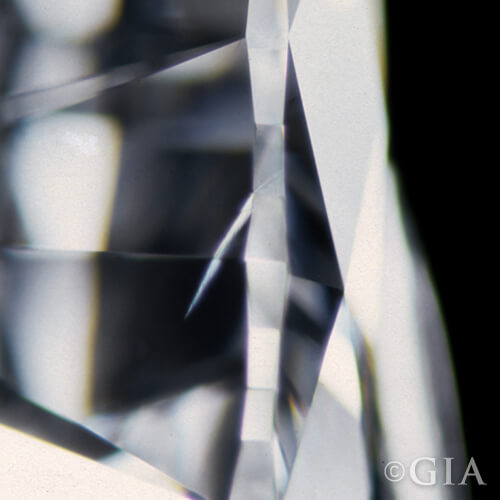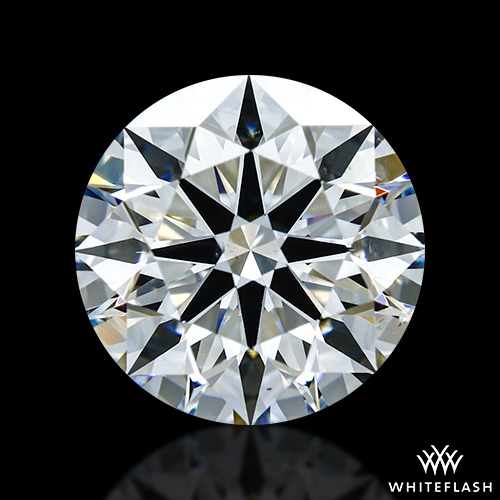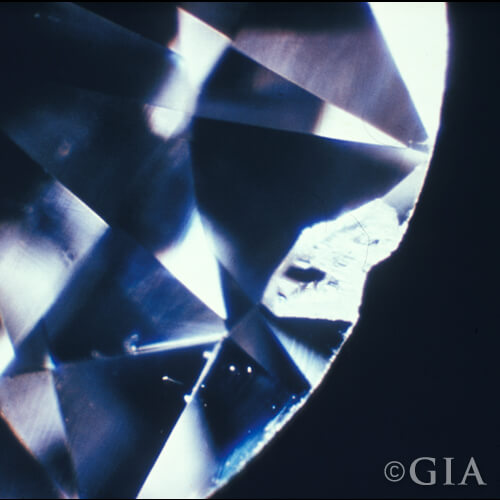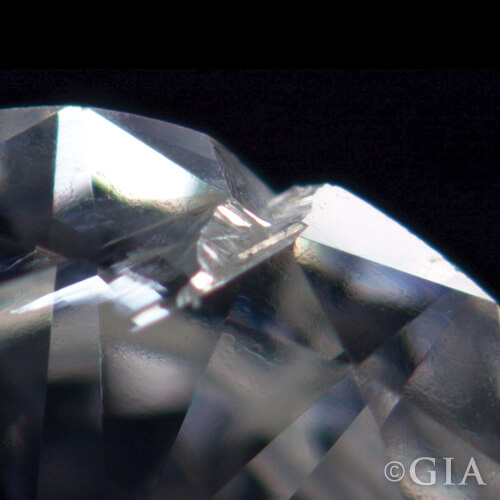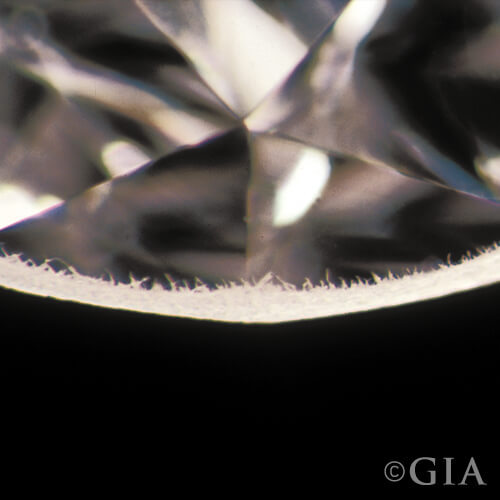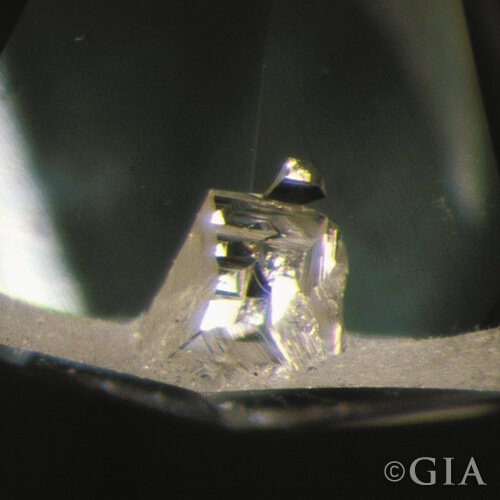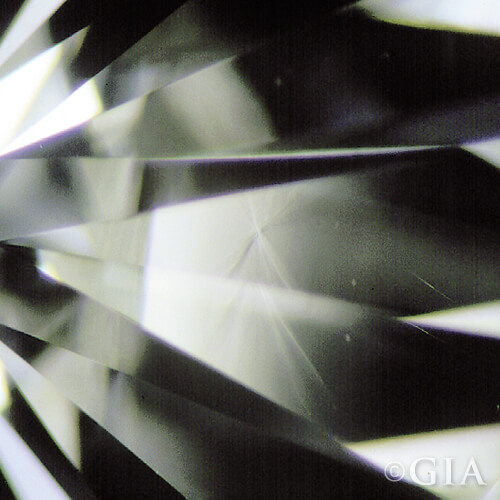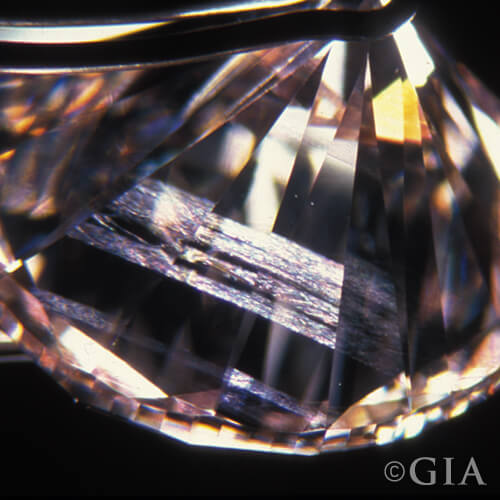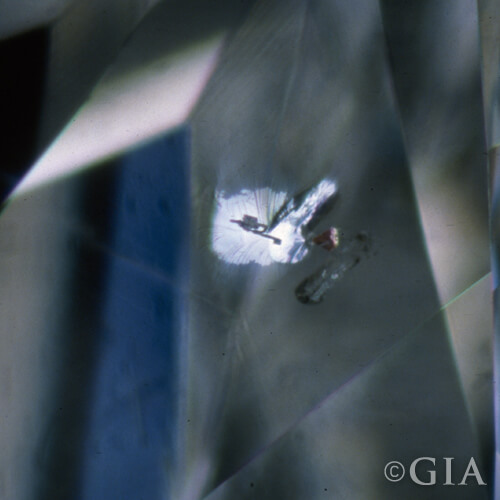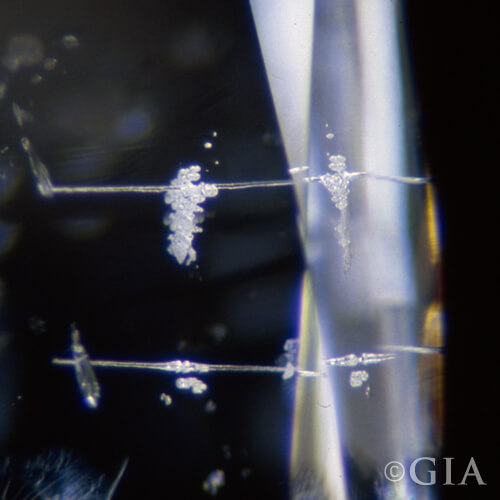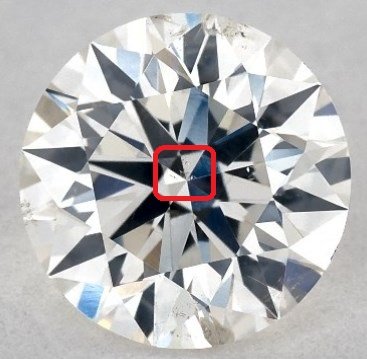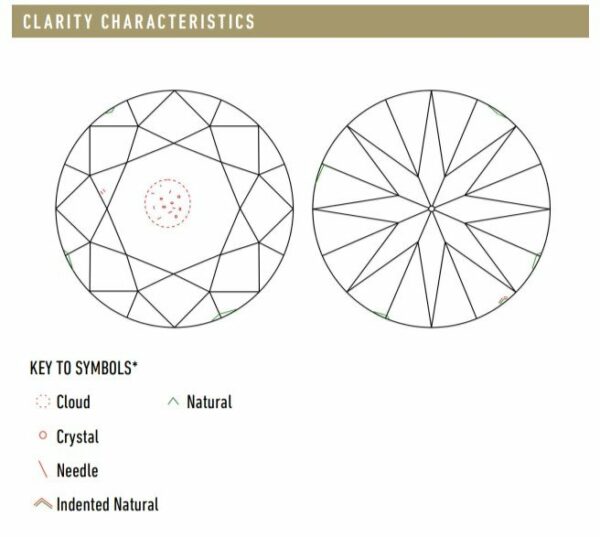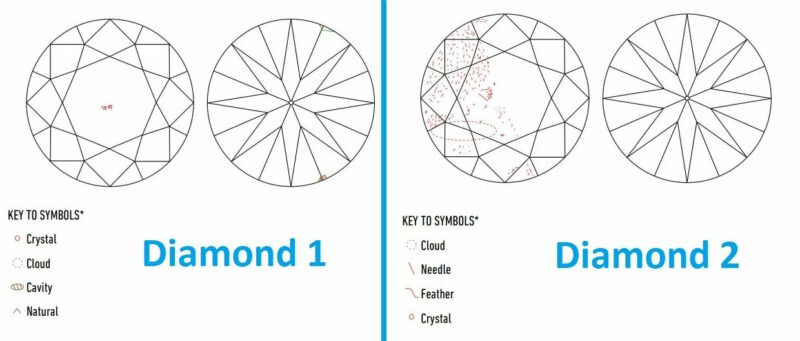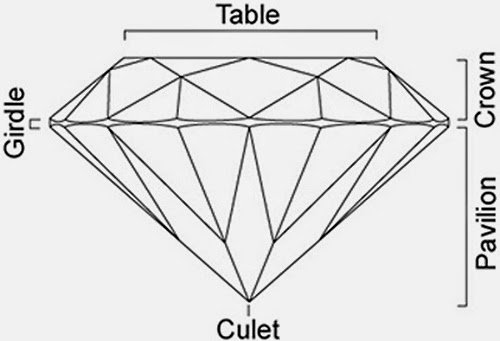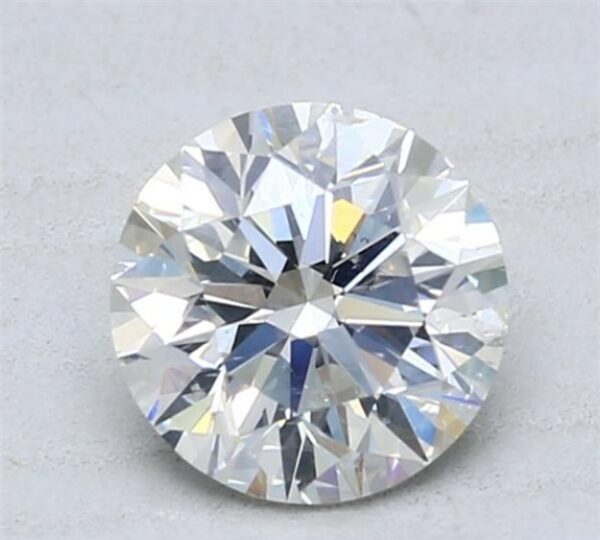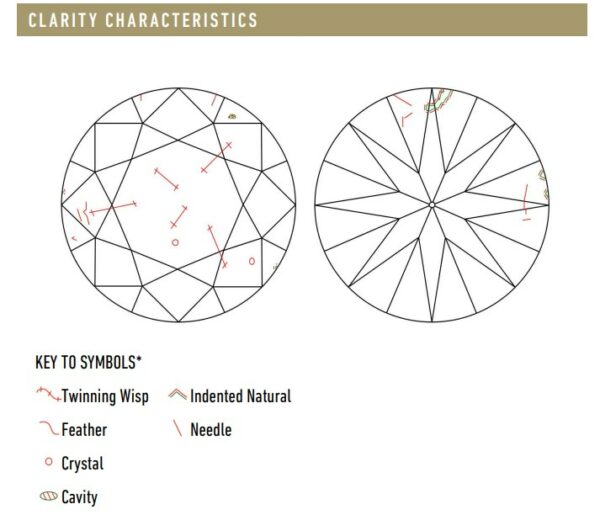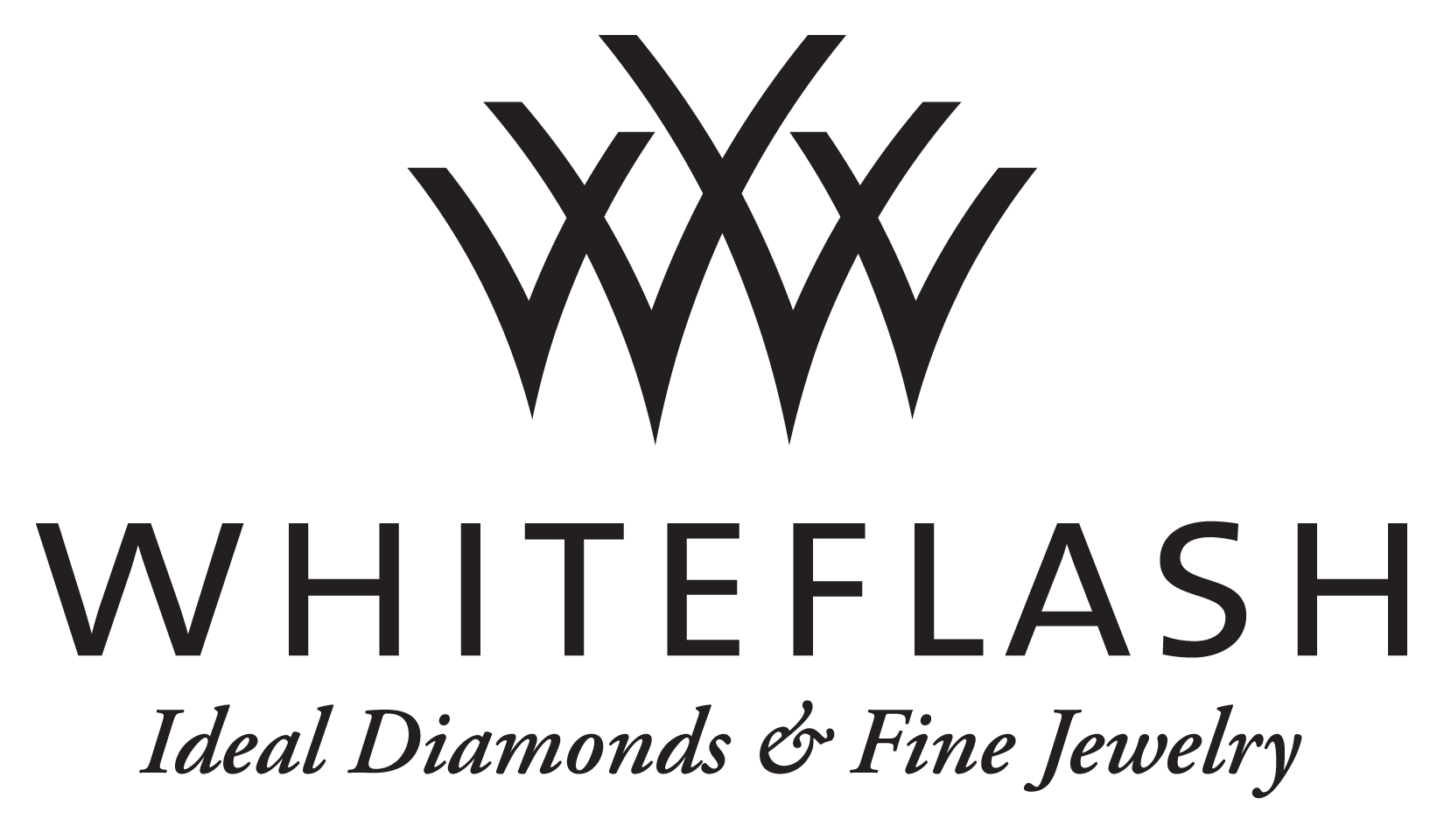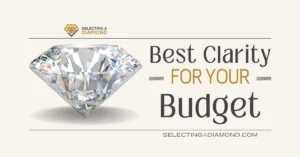Summary in a few lines:
Diamonds clarity characteristic or inclusions are small imperfections in diamonds, happen as a result of extreme heat & pressure the diamond get when formed.
Inclusions aren’t necessary bad, most of them are “okay” to be in a diamond depending on size & location, but some are NO-GO and indeed should be avoided.
Look at this stunning 1.1 H SI1 diamond on James Allen for example, although it has 4 inclusion types as listed on its GIA certificate, it’s eye clean, looks great, and will definitely be an amazing pick:
Diamonds with no inclusions are very rare, on James Allen, out of 552k diamonds, only 7k are flawless or internally flawless (flawless only are even lower, 250) as you can see in this search (less than 1.5%), the same (almost) goes for Blue Nile, with 10k out of 510k diamonds!
In short: The worst clarity characteristics (inclusions) to be avoided are Black carbon spots/crystals, Long fracture/cracks, Knots, Clouds, and in terms of position: inclusions in the diamond table center.
What are Diamond Clarity Characteristics?
Diamond clarity is a critical aspect in assessing the overall quality and beauty of a diamond. Clarity refers to the presence of natural imperfections, often termed as ‘characteristics’ or ‘birthmarks’, within or on the surface of a diamond.
These characteristics come from the immense pressure and heat deep within the Earth, and play a significant role in determining a diamond’s value and appearance.
While there are diamonds that are flawless (less than 1%), more than 99% contain imperfections, whether so tiny (invisible to the naked eye) or a little larger & more visible, these imperfections are what make each stone unique.
Clarity characteristics are a testament to a diamond’s natural origin and its journey from deep within the Earth to a cherished piece of jewelry.
Diamond Blemishes vs Inclusions
When delving into the world of diamond clarity, two key terms often surface: blemishes and inclusions. Though both contribute to the unique clarity characteristics of a diamond, they differ significantly in their nature, origin, and impact on the stone’s overall appearance and value.
In simple terms, blemishes are imperfections on the diamond’s surface, while inclusions are those found internally and do not reach its surface. Let’s take a deeper look at how they differ:
- Nature and Formation:
- Blemishes are external marks on a diamond’s surface. They can be natural or a result of the diamond cutting process. Common examples include scratches, nicks, or pits.
- Inclusions are internal flaws found within the diamond. These are naturally occurring features such as tiny crystals, feathers (small cracks), or clouds (clusters of tiny inclusions). They form as the diamond crystallizes under the Earth’s high-pressure conditions.
- Impact on Clarity:
- Blemishes, being on the surface, can often be polished or minimized during the cutting and finishing process. Their effect on a diamond’s clarity grade is usually less severe compared to inclusions.
- Inclusions, depending on their size, color, and location, can have a more significant impact on the clarity grade. Large or centrally located inclusions can notably affect the diamond’s brilliance and transparency.
- Visibility and Identification:
- Blemishes are usually more visible to the naked eye or under low magnification, as they are on the surface.
- Inclusions may require higher magnification to be seen and can be hidden strategically by skilled diamond cutters in facets or beneath prongs in jewelry settings.
Diamond Inclusion Types & Which to Avoid
Let’s uncover the most common types of inclusions found in diamonds, and see which significantly affect the stone’s appearance and value.
Based on the shape and structure, certain names have been given to the diamond inclusions, and of course, some should be avoided more than others!
In a nutshell, here are the 16 common inclusion types, before we get to discuss each one of them:
Let’s start:
1. Crystals
Crystal inclusions are essentially collections of minerals that become trapped inside a larger diamond during its formation. They can mimic the appearance of a smaller diamond within the larger one or can resemble tiny bubbles.
These inclusions come in various colors, including white, black, other colors, and sometimes even transparent (colorless) crystals. Some are so small that they are invisible to the naked eye.
White crystals can easily blend in, but black and transparent ones tend to stand out more noticeably.
The darker the color, the more you need to avoid; as it can significantly impact the diamond’s brilliance. A useful guideline is to steer clear of colored crystal inclusions whenever possible, as they are more likely to detract from the diamond’s overall beauty.
Here is a diamond from Blue Nile with a crystal inclusion on its table facet:
2. Needle
This would be one of the most common diamond inclusion types that you’ll see while shopping for your stone! Needle inclusions are usually seen under magnification as it’s not easy to detect them with the naked eye.
When diamonds are formed, the pressure could transform crystals into needle-like shapes (clustery). They usually have a white color or just transparent.
Despite the fact that diamonds are the strongest stone on earth, long and deep needle inclusions can (and will) weaken your gem; making it more vulnerable and less-harder to break!
Here is a diamond with many needles. You can notice that they’re pretty hard to spot.
Also, check out this diamond; which has a clearer needle on the table facet. Keep in mind that this is a 20x magnified image and that this inclusion is most probably not visible to the naked eye:
In most cases, needles are okay in diamonds, you shouldn’t worry about them as long they are not too deep or too long.
3. Pinpoint
Pinpoints are very tiny imperfections within a diamond, often requiring magnification to be seen. They appear as small dots, which can be white or black in color.
Among the various types of inclusions, pinpoints are regarded as diamond-friendly due to their minimal impact on the stone’s clarity.
And here is how a pinpoint appears on a magnified image of a diamond:
As you can see, it’s very small and won’t have “almost” any effect on the diamond, it’s safe to get diamond with such tiny pinpoints.
4. Clouds
Cloud inclusions are often described as clusters or groups of pinpoints or crystals within a diamond. They earn their name from the way these tiny inclusions huddle closely together, forming a ‘cloud-like’ appearance.
Typically, cloud inclusions are not visible to the naked eye. However, their impact varies depending on their size and density.
Larger and denser clouds can start to impart a slightly cloudy or hazy appearance to the diamond, affecting both its visual appeal and light performance.
This haziness can diminish the stone’s natural sparkle, which is a critical attribute of a diamond’s allure. Therefore, while small, sparse clouds may have negligible effects, larger clouds should be carefully considered for their potential impact on the diamond’s overall brilliance and beauty.
5. Twinning Wisp
Usually, the twinning wisps are found in fancy-shaped diamonds. The larger the-wisp, the lower the clarity.
A Twinning wisp looks a lot like stretch marks on a gem. It’s a bit different from the cloud inclusion in that it’s a series rather than a group of pinpoints/crystals (it even can be a series of clouds as well).
It’s been said that is caused by a pause during diamond formation and the resumption of which leaves the gem dented.
Here is a diamond with 4 twinning wisps on Blue Nile.
Generally speaking, what applies to clouds applies to twinning wisps as well, if they are large, it’s generally recommended to be avoided.
6. Knot
This is a definite NO when it comes to diamond inclusion types!
Knots can actually be seen with naked eyes and they affect the durability of the gem. These are inclusions that have reached the surface area of the gem. It’s also worth mentioning that knot blemishes extend to the surface after fashioning.
7. Feather
This inclusion is named after its shape. It is basically an internal crack inside the gem. If the crack is located cleanse to the girdle area, it could cause serious durability issues!
It’s better to be avoided if it’s large in size or reached the surface. Affecting the diamond clarity is not the big issue here! Feathers are often white and feathery (hence the name) in appearance.
This diamond on Whiteflash has two feathers right in the middle of its table, a bit to the left:
8. Chip
A chip in a diamond is an opening that typically appears on the edge or surface of the gem. Often a result of wear and tear, especially in rings, chips are not an intrinsic part of the diamond’s formation but rather a consequence of its journey through time and use.
While chips can be addressed through careful cutting and reshaping, the treatment depends on the size of the chip.
Small chips can usually be polished out or incorporated into a new cut without significantly affecting the diamond.
However, larger chips pose a challenge as fixing them might cause removing a considerable amount of material, potentially reducing the diamond’s carat weight.
Despite being a type of inclusion, chips are less commonly seen in finished diamonds.
This is because many chips can be effectively treated during the diamond cutting process, ensuring they have minimal impact on the diamond’s overall appearance and brilliance.
As a result, a well-cut diamond with a former chip may still retain much of its beauty and allure, with little to no noticeable compromise in its visual appeal.
9. Cavity
Cavities in diamonds are angular openings or holes, often located at the center of the stone.
These inclusions can form in a couple of ways: either as a part of a feather inclusion that breaks away or when a segment of a surface-reaching crystal falls out.
Despite their potentially impactful origin, cavities are usually not easily noticeable.
In general, cavities are a less prominent concern compared to more visible or structurally compromising inclusions.
However, their presence, especially in significant sizes or crucial locations, should be carefully evaluated when assessing a diamond’s quality.
10. Bruise
Bruise inclusions in diamonds are the result of an external blow to the surface of the gem, leading to tiny fractures that extend inward.
Despite the general perception of diamonds as extremely durable, they can be susceptible to such impacts, especially when struck at particular angles or points.
Bruise inclusion is less common among diamonds, and probably you won’t come across one while shopping for your diamond, but still, if you find a diamond with a bruise, watch out for visible/large ones; because it’s that type of inclusion you want to avoid in your diamond.
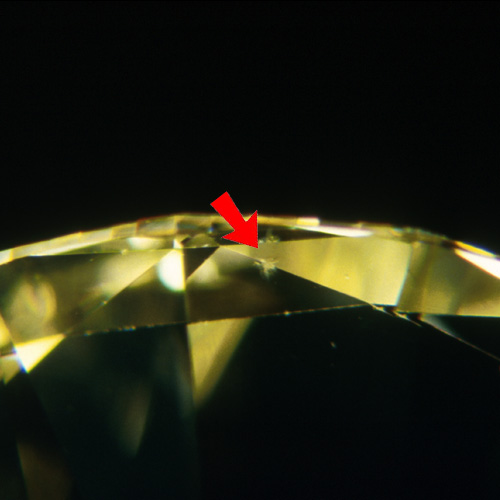
11. Bearded Girdle – Bearding
Bearded girdle inclusions, commonly referred to as bearding, typically arise during the cutting stage of a diamond. This type of inclusion gets its name from its resemblance to fine, hair-like fibers encircling the girdle, or the outer edge, of the diamond.
While minimal bearding can often be inconsequential and easily overlooked, heavy bearding on the girdle is more concerning.
The appearance of a heavily bearded girdle is characterized by a grey, fuzzy fringe that can give the diamond a somewhat scratched or rough look. This is not an ideal aesthetic for a gemstone prized for its clarity and brilliance. Extensive bearding can detract from the overall beauty of the diamond, making it appear less polished and refined
12. Indented Natural
An Indented Natural is a remnant of a diamond’s original rough surface that remains visible, dipping below the polished surface of the finished gem.
This inclusion occurs when a diamond cutter opts to leave a portion of the natural surface to maximize carat weight, balancing between the stone’s size and its polished appearance.
Small indented naturals may not significantly impact the diamond’s aesthetics, but larger are more noticeable and can affect its smoothness and symmetry, influencing both appearance and value.
This diamond on Blue Nile has 3 indented natural diamonds as you will see in the certificate. These inclusions are extremely tiny that they’re almost invisible even under 20x magnification, so generally-speaking, intended natural inclusions are okay to be in a diamond.
13. Grain Center
A Grain Center is a type of inclusion characterized by a small, concentrated area of crystal distortion within a diamond.
This distortion can manifest in different colors, often appearing white or dark, and might resemble like a thread or a pinpoint formations.
While typically subtle, the visibility and impact of a grain center on the diamond’s overall appearance can vary depending on its size, color, and location within the stone.
14. Internal Graining
Internal Graining in diamonds refers to visible lines, angles, or curves that are caused by irregularities in the crystal growth process. These features can appear as whitish, colored, or reflective marks within the stone and may impact its transparency, especially when viewed under 10x magnification.
The presence and prominence of internal graining can vary, affecting the diamond’s clarity and overall appearance to differing degrees.
15. Internal Laser Drilling
Internal Laser Drilling is a technique used to modify diamonds, involving the use of a laser to create or expand a feather-like inclusion that reaches the surface of the diamond. This process typically targets a dark inclusion, creating a pathway (in the form of a feather) to the surface.
The purpose of this pathway is to provide access for subsequent treatments, like bleaching, which are used to decrease the visibility of the original inclusion.
This method alters the natural state of the diamond, aiming to improve its aesthetic appearance by making certain inclusions less noticeable.
However, it’s important to note that such treatments can affect the diamond’s value and are usually disclosed in gemological reports.
16. Laser Drill-hole
A small, surface-reaching tunnel in a diamond that is created using a focused laser beam.
This is done to provide access to internal inclusions, usually for the purpose of treating or modifying them. The drill-hole itself is typically very narrow and may be challenging to detect with the naked eye.
Despite its minimal appearance, the presence of a laser drill-hole is a significant factor in evaluating a diamond’s authenticity and natural state, as it indicates human intervention in the gem’s appearance.
You might wonder: What’s the difference between laser drill-hole & internal laser drilling?
A laser drill-hole is a small, surface-reaching tunnel created to provide access to the interior of a diamond, often for treating specific inclusions, and is usually minimally visible.
In contrast, internal laser drilling involves using a laser to modify or treat an inclusion within the diamond, such as creating or expanding a feather-like inclusion for treatments like bleaching to decrease the visibility of another inclusion.
While both are forms of human intervention, internal laser drilling is more invasive, altering the diamond’s internal structure, as opposed to the simpler pathway creation of a laser drill-hole.
17. Growth Remnant
An additional, inclusion type that only happens in lab-grown diamonds is growth remnant. Growth remnants are inclusion type within the diamond that are remnants of the crystal’s growth process.
Lab-grown diamonds are created through technological processes that replicate the conditions under which natural diamonds form in the Earth’s mantle. These processes can include High Pressure High Temperature (HPHT) and Chemical Vapor Deposition (CVD). During the growth of a lab-grown diamond, various factors can influence its characteristics.
“Growth remnant” refers to residual elements or features left behind during the diamond growth process. This could include small imperfections, inclusions, or structural elements that are remnants of the growth process.
18. Minor Details of Polish
Polish refers to the smoothness and overall condition of the diamond’s surface, particularly the facets. Minor details of polish as a clarity characteristic of diamonds, usually involve examining the tiny imperfections or irregularities on the surface of the stone.
The impact of these minor details on the overall appearance and value of a diamond depends on their size, number, and visibility. Diamonds are typically graded on a scale that includes categories for polish, ranging from Excellent to Poor. The Gemological Institute of America (GIA) and other gemological laboratories provide standardized grading criteria for polish and other clarity characteristics.
When purchasing a diamond, especially for an engagement ring or other significant jewelry, it’s advisable to consider the overall clarity grade, which takes into account various factors, including polish, to ensure you are getting a diamond that meets your desired quality standards.
Inclusion Types Summary
In exploring these 16 types of diamond inclusions, we saw that each inclusion type tells a unique story of the gem’s formation and journey, contributing to its distinctiveness.
Understanding these inclusions is not only fundamental for making informed diamond selections but also for appreciating the natural beauty and authenticity of these precious stones.
Just looking at the diamond itself isn’t enough. You MUST read the certificate to understand what types of inclusions the diamond has and how they affect its clarity!
Pro Tip: The clarity section in the GIA certificate is only available for diamonds with 1 carat and above. We’re mentioning this so that you won’t be surprised if you don’t see a clarity section in your GIA certificate!
What Diamonds Inclusion You Should Avoid
Whether you call it an inclusion, a blemish, or clarity characteristics, there are certain types of these imperfections that you should be very careful when they are present in the diamond.
As each of the 12 different inclusion types we mentioned above is different, their effect on diamonds ability to reflect light, appearance, and even durability varies.
In a nutshell, here are the worst inclusions to be avoided, graded with No.1 being the worst:
1. Black Carbon Spots / Crystals:
The light passing through the stone will be literally blocked (in the exact spot of the black crystal). These inclusions will look like tiny pieces of crushed black pepper.
These are the worst inclusions; you better avoid them whenever found, on or underneath the surface of your diamond for that matter.
Remark: Note that we are only talking about black-colored crystals.
2. Top / Center-Located Inclusions:
Generally speaking, any notable inclusion located on the top or in the center is quite harmful to your gem!
Look at this diamond on James Allen’s and check out the inclusion located in the middle.
This location specifically is such a killer of a diamond’s brilliance. (This diamond has many other visible inclusions as well, but we wanted to highlight how important the location of inclusion is).
Whenever you’re looking for a diamond, just try your best to get a clean top-surface diamond (diamond table).
3. Long Fracture / Crack:
Have you ever imagined that a diamond is breakable? What about the 10/10 grade of strength on the Mohs Scale of mineral hardness?
The diamond has a short needle? Not a big deal. However, a long/deep needle/crack is a serious issue; as it runs all the way through the diamond!
Slamming such diamond to a wall too hard might also crack it (or even split it into halves!). It’s rare and totally dependent on the crack depth and length as well.
If you look right through this diamond; 6 o’clock sharp, you can clearly see a long crack. Not too long to break a diamond, but definitely an inclusion you’d want to avoid!
4. Clouds:
Back to our clouds! Small clouds? Those we can ignore. It’s the cloud covering a big portion of the diamond’s surface that we can’t!
By leaving the diamond looking hazy and milky, clouds affect the look, and more importantly, the brilliance of a gem.
Look at this diamond in 360-degree on the Blue Nile. Also, a screenshot of its clarity section on its GIA certificate as well:
It’s not only that the cloud is covering a lot of space on the diamond surface, what’s worse is the location, right in the middle of the table facet.
5. Knot
It’s always a NO-GO when the diamond has a knot inclusion, it can really get worse by time so even if it minor, it might be more visible by time.
Inclusions Characteristics Effect on Clarity Grading
By now, we know for a fact that not all inclusions are equal, but beside the type, what are other factors that should be taken into consideration when assessing an inclusion?
Look at these two diamonds on Blue Nile and their clarity section in the image after:
And particularly on diamond 1 lower girdle facet (bottom right at 5 o’clock), you will see there is a small inclusion there, and on the keys section, it will tell you that this inclusion is Cavity.
This inclusion type & location degrades the clarity and the grade of the stone to SI1, but it’s not the only factor causing this step down!
The inclusions found on the very first image to the left (crown of the 1st diamond) are located at the worst location in a diamond (look again here using 360-degree, it’s easily visible).
In many cases, they will be seen by naked-eye, and more importantly, they hugely affect the diamond’s brilliance since light passes through the crown first.
The first one has around 9 “tiny” inclusions on its crown, and this is “relatively” a low number of inclusions, yet it was graded as SI1 not higher!
The second one has tons of inclusions all over its crown! And it was graded SI1, the same as the first one. Why is that?
Basically, because each inclusion impacts the gem differently. As we said before, no two inclusions are identical. Some can really harm the diamond’s brilliance; messing up its ability to reflect the light, others don’t.
Here are the main factors for how a clarity characteristic/inclusion can affect diamond clarity grade:
1. Size
First comes the inspection (under 10x magnification; since inclusions are mostly visible under magnification), then comes the grading of the gems. The size of the inclusion has a huge impact on the grading.
Larger inclusions lead to lower grading, and vice versa. This totally makes sense actually, since eye-clean diamond (VS2 for example) will not have any inclusions that you can see, whereas the same exact inclusions (if existed) with a larger size will probably make the same diamond an SI1.
2. Number
Numerous inclusions in a gem leave it unattractive as well as affecting its grading.
3. Relief
Low relief means that the inclusion’s color is close to the stone’s color. Therefore, inclusions like crystals that are translucent or white have less impact on the gem than dark ones.
4. Type
Various types of inclusions impact the clarity and the grading of a gem in various degrees. For instance, pinpoints have a lesser impact because they are barely visible (even under 10x magnification). Other inclusions like feathers can have a greater impact as they could cause a gem to crack.
5. Location
The location of the inclusion matters! Where the inclusion is situated in the gem goes a long way in grading, look at this image for example:
If an inclusion is at the table facet, it is the most visible of all and generally affects how the gem is seen (since the table facet is like the mirror of the gem), also it is the first place considered when looking at a gem.
When located at the girdle, it is rarely visible. Inclusions at the culet are another story! They reduce the value of the gem tremendously given that they can reflect throughout the whole gem.
In a nutshell, inclusion location is very important to determine clarity grade and overall brilliance, always look for a diamond with less or no inclusions on the top, or on the girdle (and its upper/lower facets).
How Inclusions Look Like?
As a matter of fact, there are many diamond inclusion types. For instance, the image you see here is for a diamond with an SI2 clarity grade on “Blue Nile”, that diamond actually has 6 diamond inclusion types!
We’re not saying 6 inclusions, no it has 6 different types of inclusions:
If you take a look at the GIA certificate of that diamond, and in particular its clarity section, what you’ll see is a clear representation of all clarity inclusions found on the diamond, their locations, and types!
A valid question here: Is this a diamond that I should pick or avoid?
Well, it’s 1.5 carats and considerably cheap for that carat & an excellent cut, but with all these visible inclusions, we don’t think so!
Hmm, you mean I should always look for a flawless/internally-flawless diamond?!
Definitely no, actually we always recommend to start with SI1 clarity for most cases.
Want to see how a diamond with clear clarity looks like without going insane in clarity grade?
Say no more!
Check this diamond on James Allen’s site, looks way better! And it’s just VS2 graded, this is 20x magnification of the diamond:
And here is its clarity section from the GIA certificate:
Huge difference, right?
That diamond has a VS2 clarity grade, which is just one grade higher than SI1!
You see the value of getting & checking the diamond certificate before proceeding with the purchase! And make sure that the certificate is from high-reliable labs like GIA.
That’s why we always considering James Allen, Blue Nile or Whiteflash when you’re getting a diamond, they provide diamonds certification on spot for any diamond you want.
Quick Overview of Clarity Table
Clarity is one of the 4Cs of diamonds and considered one of the main pillars in specifying a diamond worth. In GIA standards, clarity is graded into 6 categories based on the cleanness of a diamond.
We’ve covered the detailed grades with real images in our Diamond Clarity Chart, but for the sake of summarizing, we’ll mention the grades below:
1. Flawless
Diamonds graded FL have no visible inclusions or blemishes to the eye at 10x magnification. These diamonds are extremely rare and are very expensive. Only 1 in 5000 diamonds are rated flawless.
2. Internally Flawless
These are diamonds that do not have inclusions but only blemishes. These blemishes are barely visible under 10x magnification. Only about 3% of diamonds are ever rated IF and if put side by side with FL, they are quite similar to the unskilled eye.
3. Very Very Slightly Included
Even at a 10x magnification, inclusions in diamonds here are still difficult to see. For VVS1, inclusions can only be seen from the pavilion while for VVS2 diamonds, their inclusions can only be seen from the crown.
For both, the inclusions are of course not visible to the naked eye and look similar to the flawless grades. These diamonds have clarity and are equally expensive.
4. Very Slightly Included
These are considered minor inclusions. They are very visible under 10x magnification, however, they’re not visible to the naked eye. Their slight inclusions do not affect the clarity or the transparency. These gems are categorized into VSI1 and VSI2.
5. Slightly Included
This grade contains diamonds having visible inclusions under 10x magnification. Some of them are also visible to the naked eye when examined under close inspection. They are divided into SI1 and SI2 gems (EGL introduced SI3, but it’s not internationally adopted).
Feel free to read our EGL vs. GIA comparison guide if you ever thought about getting an EGL diamond.
6. Included
Diamonds under this grade have inclusions that are obvious under 10x magnification. The inclusions are always visible to the naked eye and might even affect the durability of the gem. They also reduce transparency and the brilliance of the gem. They are divided into I1 through I3, don’t ever get any of them!
You can also read: What is the Best Budget-Friendly Diamond Clarity?
1 Carat Diamond Price for Different Clarity Grades
After all that’s been said, it would be safe to mention how these inclusions (which define the clarity grade for any diamond) affect diamond pricing.
Comparing an apple to an apple, we will be freezing our search to these characteristics, and then see how changing the clarity level affects the pricing in each!
Cut: Excellent
Carat: 1
Color: G
Polish & Symmetry: Excellent
Fluorescence: None
Shape: Round
Certificate: GIA
We will use our favourite online store James Allen as a price reference; as it has one of the largest diamond inventory and more than 500,000 unique options for diamonds!
Regardless of how much money you have and find reasonable for the price of your ring, we recommend shop diamonds online and definitely believe it’s a responsible decision! The savings are incredible and the quality is great. You can check one of our favorite online stores: James Allen, Blue Nile, and Whiteflash.
1 Carat SI2 Clarity Price Range
After running a search on James Allen’s with the above-mentioned characteristics, the result was 400 diamonds, with prices ranging between $2.9k and $5.9k.
1 Carat SI1 Clarity Price Range
This search on James Allen’s with the above-predefined filters resulted in 311 diamonds, ranging between $4.8k to $7.4k.
Note the huge increase in price (for just one grade in clarity). That’s simply because SI2 is not eye-clean in most cases, while SI1 is the exact opposite, eye-clean in most cases.
That’s why we always start your clarity search from SI1 since it’s good enough for almost everyone.
1 Carat VS2 Clarity Price Range
A similar search here, returned 309 diamonds, from $5.9k to $8.2k.
Again, a huge increase in price. Think about it for a second, people resort to VS2 to stay safe in terms of visible inclusions; since it’s 100% eye clean.
1 Carat VS1 Clarity Price Range
We got 234 diamonds, prices varied between $7.3k and $9.1k.
1 Carat VVS2 Clarity Price Range
183 diamonds, with a price range of $7.6k and $9.3k.
1 Carat VVS1 Clarity Price Range
81 diamonds, ranging between $8.7k and $10k.
Going to FL & IF would be insane, see how much difference people are paying for something that has no major effect on diamond? Go to VS2 and your diamond will be great, why paying $5k more for something a salesperson have said?
Summary
When you’re set on getting your diamond, watch out for the inclusions. Nonetheless, keep in mind that inclusions can only be visible where the gem is loose.
However, when the gem is in its setting (mounting style on the ring; holding it in place), grading might be difficult; since the setting (prongs or bezel) might be covering the inclusions somehow!
This could also be a good thing when deciding to purchase a gem with inclusions. The setting could be made to hide the inclusion 😉
FAQ:
What does clarity characteristics cloud mean?
A “clarity characteristic cloud” refers to a group of tiny, closely spaced inclusions or imperfections within the stone that, when viewed together, create the visual appearance of a hazy or cloudy area. These inclusions are typically made up of very small crystals, pinpoints, or other types of mineral matter.
The term “cloud” is used because, when these minute inclusions are closely grouped, they can have a visual effect similar to looking through a cloud. The presence of a cloud can affect the transparency and brilliance of the diamond, potentially impacting its overall appearance. The severity of the impact depends on the size, density, and location of the inclusions within the stone.
What are pinpoint clarity characteristics?
“Pinpoint” is a term used in the diamond industry to describe very small, often microscopic, crystals that are embedded within a diamond. When pinpoint inclusions are present in a diamond, they are considered a type of clarity characteristic. Pinpoints can be crystals of various minerals or even tiny air bubbles trapped during the diamond’s formation.
In gemological grading reports, such as those provided by the Gemological Institute of America (GIA), pinpoint inclusions are typically assessed under magnification. The size, quantity, and location of these pinpoints play a role in determining the diamond’s overall clarity grade.
What are the best inclusions to have in a diamond?
While many people aim for diamonds with minimal or no visible inclusions, some inclusions can be interesting and unique, adding character to the diamond. Here are a few types of inclusions that are often considered less detrimental to a diamond’s appearance:
- Pinpoints: Very small crystals or tiny mineral inclusions that are often not visible to the naked eye. In moderate amounts, pinpoints can contribute to a diamond’s uniqueness without significantly affecting its appearance.
- Needles: Long, thin crystals that resemble needles. In some cases, needles can create interesting patterns and are not always easily visible without magnification.
- Clouds: A group of very small inclusions closely spaced together that can create a hazy or cloudy appearance. In some cases, a faint cloud might not be noticeable to the naked eye and can add a degree of uniqueness to the diamond.
- Feathers: Small fractures or cleavages within the diamond that may resemble tiny feathers. In some cases, feathers may be invisible to the naked eye and add character to the diamond.
It’s important to note that the acceptability of certain inclusions can vary from person to person. While some may appreciate unique characteristics that make a diamond distinctive, others may prefer a stone with minimal inclusions for a cleaner and more traditional look.
What is a bad diamond clarity?
The clarity of a diamond is graded on a scale ranging from “Flawless” to “Included.” The grades are determined based on the presence of internal inclusions and external blemishes. A diamond with higher clarity is generally considered more valuable. We generally don’t recommend getting anything below SI1.
Which diamond clarity is best?
The best diamond clarity for you depends on your preferences, budget, and how much emphasis you place on a diamond’s clarity when considering the overall appearance. The Gemological Institute of America (GIA) grades diamond clarity on a scale ranging from Flawless (no inclusions or blemishes visible under 10x magnification) to Included (inclusions and/or blemishes visible to the naked eye)
For most consumers, diamonds in the VS (Very Slightly Included) and SI (Slightly Included) ranges offer a good balance between quality and value. Diamonds in these ranges often appear eye-clean (no visible inclusions without magnification) and are more budget-friendly than higher clarity grades.
Is VS1 clarity good?
Yes, a VS1 (Very Slightly Included 1) clarity grade is considered very good and represents a high level of clarity in a diamond. The Gemological Institute of America (GIA) grades diamond clarity on a scale ranging from Flawless (no inclusions or blemishes visible under 10x magnification) to Included (inclusions and/or blemishes visible to the naked eye). The VS1 grade is part of the Very Slightly Included (VS) category.
Many VS1 diamonds are considered “eye-clean,” meaning that the inclusions are not visible to the naked eye when the diamond is viewed without magnification. This is often an important consideration for those who prioritize visual clarity without a significant budget constraint.
Still not sure where to buy your diamond?
We always recommend shopping diamonds online and created a Full guide to shop diamonds like a Pro.
Among online retailers, here are our favorite stores click their logo to visit store
-
James Allen:
Our favorite online store, best diamond imaging technology available today, comes with the largest collection with more than half a million loose diamonds.
-
Blue Nile:
Widest collection of loose diamonds of all sizes, great imaging technology for most of their inventory (hundreds of thousands of diamonds), great customer support.
-
Whiteflash:
Home Of A CUT ABOVE® Super Ideal Diamonds, they stand out from the crowd by offering premium diamonds cuts, tailored to those who love the details, at great prices too.

